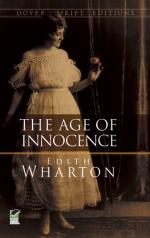There was one episode, in particular, that held the house from floor to ceiling. It was that in which Harry Montague, after a sad, almost monosyllabic scene of parting with Miss Dyas, bade her good-bye, and turned to go. The actress, who was standing near the mantelpiece and looking down into the fire, wore a gray cashmere dress without fashionable loopings or trimmings, moulded to her tall figure and flowing in long lines about her feet. Around her neck was a narrow black velvet ribbon with the ends falling down her back.
When her wooer turned from her she rested her arms against the mantel-shelf and bowed her face in her hands. On the threshold he paused to look at her; then he stole back, lifted one of the ends of velvet ribbon, kissed it, and left the room without her hearing him or changing her attitude. And on this silent parting the curtain fell.
It was always for the sake of that particular scene that Newland Archer went to see “The Shaughraun.” He thought the adieux of Montague and Ada Dyas as fine as anything he had ever seen Croisette and Bressant do in Paris, or Madge Robertson and Kendal in London; in its reticence, its dumb sorrow, it moved him more than the most famous histrionic outpourings.
On the evening in question the little scene acquired an added poignancy by reminding him—he could not have said why—of his leave-taking from Madame Olenska after their confidential talk a week or ten days earlier.
It would have been as difficult to discover any resemblance between the two situations as between the appearance of the persons concerned. Newland Archer could not pretend to anything approaching the young English actor’s romantic good looks, and Miss Dyas was a tall red-haired woman of monumental build whose pale and pleasantly ugly face was utterly unlike Ellen Olenska’s vivid countenance. Nor were Archer and Madame Olenska two lovers parting in heart-broken silence; they were client and lawyer separating after a talk which had given the lawyer the worst possible impression of the client’s case. Wherein, then, lay the resemblance that made the young man’s heart beat with a kind of retrospective excitement? It seemed to be in Madame Olenska’s mysterious faculty of suggesting tragic and moving possibilities outside the daily run of experience. She had hardly ever said a word to him to produce this impression, but it was a part of her, either a projection of her mysterious and outlandish background or of something inherently dramatic, passionate and unusual in herself. Archer had always been inclined to think that chance and circumstance played a small part in shaping people’s lots compared with their innate tendency to have things happen to them. This tendency he had felt from the first in Madame Olenska. The quiet, almost passive young woman struck him as exactly the kind of person to whom things were bound to happen, no matter how much she shrank from them and went out of her way to avoid them. The exciting fact was her having lived in an atmosphere so thick with drama that her own tendency to provoke it had apparently passed unperceived. It was precisely the odd absence of surprise in her that gave him the sense of her having been plucked out of a very maelstrom: the things she took for granted gave the measure of those she had rebelled against.




